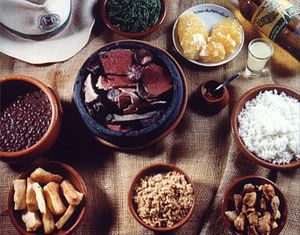Feijoada facts for kids

Brazilian-style feijoada with common side dishes
|
|
| Type | Stew |
|---|---|
| Place of origin | Portugal,Brazil, Angola, Cape Verde, Guinea Bissau, Mozambique, Sao Tome and Principe, Goa, Macau, East Timor |
| Main ingredients | beans, beef, pork |
Feijoada (Portuguese pronunciation: [fejʒuˈadɐ]) is a delicious stew made with beans, beef, and pork. Its name, feijoada, comes from the Portuguese word feijão, which means 'bean'. This hearty dish is very popular in many countries where Portuguese is spoken, like Portugal and Brazil. Each place might have its own special way of making it!
The main ingredients are always beans, fresh pork, or beef. In Brazil, people usually make feijoada with black beans. It's best cooked slowly in a thick clay pot.
Feijoada is often served with rice and different kinds of sausages. These sausages can include chouriço or morcela (blood sausage). Sometimes, these sausages are cooked right in the stew.
Contents
Brazilian Feijoada: A National Dish

Many of today's feijoada recipes come from popular versions in Brazilian cities. These include Rio de Janeiro, São Paulo, Recife, and Salvador. In Brazil, feijoada is seen as a very important national dish.
Feijoada was first written about in Recife, in the State of Pernambuco. It is especially famous in Rio de Janeiro. The Brazilian version, called feijoada completa, uses black beans. It also has many kinds of salted pork or beef. These can include pork ears, tail, feet, bacon, smoked pork ribs, and different smoked sausages. You might also find jerked beef (dried beef) in it.
The finished dish has beans and meat pieces covered by a dark, rich broth. It tastes strong and a bit salty, mostly like black beans and meat stew. People usually eat it with white rice and orange slices. The oranges are thought to help with digestion. Other common side dishes are couve, which are stir-fried collard greens, and farofa. Farofa is a crumbly topping made from manioc flour.
Feijoada is often a special meal for celebrations. It's traditionally served on Saturday afternoons or for Sunday lunch. It's meant to be a relaxed, long meal, not something eaten quickly. Families often enjoy it together, perhaps while watching a soccer game. Because it has many rich ingredients, feijoada is sometimes called Brazilian soul food. In São Paulo, many restaurants serve feijoada on Wednesdays and Saturdays. In Rio de Janeiro, it's often served on Fridays. You can sometimes choose the meats you want in your feijoada. There are even lighter or vegetarian versions available today.
Where Feijoada Came From
Stew dishes with meat and vegetables have a long history. They can be traced back to ancient Roman cuisine. As the Roman Empire grew, these dishes spread. They led to similar meals in other countries. Examples include French cassoulet and Spanish fabada asturiana. Feijoada from Northern Portugal also came from these early stews.
Black beans were first grown by native people in the Americas. They were cheap and easy to grow. This made them a very important food for European settlers in Brazil. Both rich and poor people ate black beans. Wealthy people enjoyed them with different meats and vegetables, much like feijoada. However, poor people and enslaved people often ate black beans mostly with manioc flour.
Some food historians compare Feijoada to soul food in America. They suggest that it, along with some of its traditional side dishes from Africa, came from enslaved people. They used the ingredients they had to create delicious and filling meals.
Feijoada Around Brazil
The type of bean used in feijoada can change depending on the region in Brazil. In the southeast, like Rio de Janeiro and Minas Gerais, black beans are most common. But in Bahia, Sergipe, and Goiás, people often use brown or red beans.
In most parts of Brazil, feijoada is just beans and meat. However, in Bahia and Sergipe, people sometimes add vegetables. These can include plantains, kale, potatoes, carrots, cabbage, and pumpkins. These vegetables are usually added near the end of cooking. They cook from the steam of the stew.
Feijoada in Pop Culture
In 1977, a famous Brazilian musician named Chico Buarque released a song called "Feijoada Completa." The song's words describe all the ingredients and how to make feijoada. It also talks about how people usually eat it.
Feijoada was also shown on the Netflix TV series Street Food. This show explored street foods from different places in Latin America.
See also
 In Spanish: Feijoada para niños
In Spanish: Feijoada para niños


